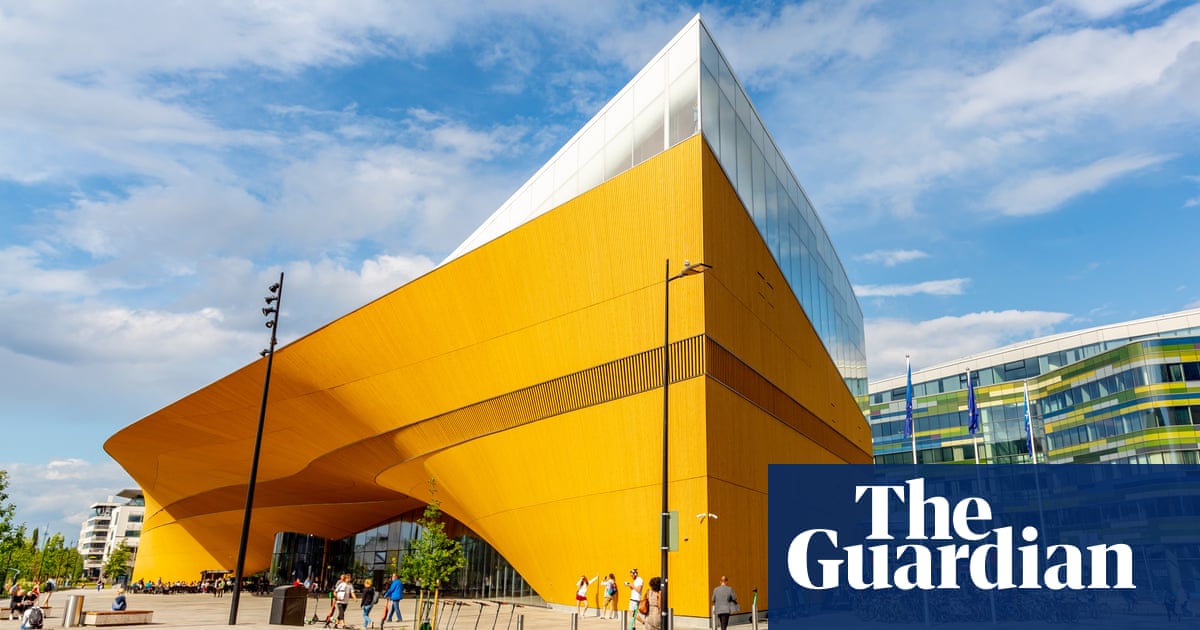
Outside the futuristic glass-and-metal tiers of De Krook, Ghent’s city library, stands a statue: four giant, brightly painted figures leaning tightly in towards each other, their heads all but touching – as if telling each other something.
“And that’s really what it’s about,” said service and communications coordinator Els Van Rompay. “This is more than a library, though books are its core. It’s also a place to learn, connect, develop, collaborate. Or just to be. A meeting place for our minds.”
De Krook is not alone. All also built in the past seven or eight years, Helsinki’s Oodi central library, Dokk1 in Denmark’s Aarhus, and Deichman Bjørvika in Oslo share much the same vision of the library: in effect a living room for the 21st-century city.
Walk through the front doors of De Krook – named after the bend in the Scheldt river on which it sits, linking the medieval city centre of Belgium’s third biggest city with its university quarter – and you join more than 4,000 others who also do so every day.
They range in age from primary school pupils on a class visit to the children’s lending library on the lower ground floor, with cosy reading boxes to curl up in and multilingual digital storytelling machines, to pensioners coming for an internet lesson.
“I love it,” said Eline, 63. “I come once a week, to read the papers, borrow a book, go to a talk.” Luc, recently retired, said the building’s uncompromising modernity had been off-putting at first, “but now I like it, a lot. And it’s something we have together.”
Baris, 20, was revising for his end-of-term university exams at one of the building’s 1,000 workspaces. “It’s a cool place,” he said. “A mix of quiet and busy areas, you can work or hang out.” Effie, 43, liked the cakes and the third-floor views of the old town.
Since it opened in March 2017, replacing an array of semi-derelict, mostly industrial buildings, De Krook, designed by a team of Catalan and Belgian architects, has been hailed as a “connection point”, a “landmark” and a “cultural catalyst” by critics.
Crucially, however, it was greeted rapturously by locals, Van Rompay said. “We put out a bit of a symbolic call to ‘help us move the books’ from the old library, and just so many showed up,” she said. “The opening weekend, we got 20,000 visitors.”
Inside, no two floors are the same. Vast windows, high atria and wide staircases scattered with cushions create a sense of a “city within the city”; a bright cafe-restaurant sits next to an expansive newspaper and magazine reading space.
Downstairs is a “makers’ room” with laser cutters, 3D printers, sewing machines and soldering equipment. There’s a fully equipped, always-busy student radio studio, and advice centres to help with legal questions and adult education choices.
At the DigiPoint on the second floor, a city hall staffer and a rota of volunteers are on hand to guide – usually more elderly – library users through the digital maze: filling in online forms, booking a dentist’s appointment, extending a library loan online.
A language hub offers materials in English, French, Arabic and Turkish, with a focus on learning Dutch: Ghent’s 260,000 inhabitants (plus 60,000 students) are increasingly diverse and half the city’s younger children do not speak Dutch at home.
Meeting rooms on every floor host lectures, talks and conferences. There have been slam poetry readings on the stairs and piano concerts in the lobby. Membership is free, and comes with unlimited wifi and two hours of computing time a day.
Community involvement is not an empty term, said De Krook’s information officer, Bart Vanlerberghe. The library’s partners are the city and region, but also Ghent university and Imec, a leading Flemish nano- and digital technology R&D lab.
Both help run a series of innovative projects driven by citizens and facilitated by the library. A programme called Comon aims to devise technological solutions to local people’s concrete problems, as identified in public meetings at the library.
The first focus was on “understandable healthcare”: citizens brainstormed fixes; students worked on testable prototypes; researchers developed products that worked (such as a smartwatch to measure and record pain). The next will look at mobility.
For all its newfound task as “knowledge navigator and facilitator” in an increasingly complex and connected world, the library’s traditional role has also benefited from its new home: library book loans, far from declining, have risen by almost 10%.
“It’s kind of like the still centre,” said library coordinator Ingrid Verdonck. “A place to breathe, really. As well as to connect.” The city’s 14 interconnected local libraries share the same vision, said Yves Rousseau in the Ledeberg branch.
“It’s really about building a real relationship with our users and communities – finding out what they want, and providing it,” he said. One demand was out-of-hours access, which Rousseau’s branch should start offering in 2024, using an app and QR code.
Throughout its development and initial opening phase, De Krook’s management worked in consultation with the team at one of Europe’s new library pioneers, Dokk1 in Aarhus, Denmark’s second city, which opened two years earlier, in 2015.
A similarly award-winning, futuristic and transparent building, Dokk1 – on the port waterfront – is part of a larger complex including a multimedia centre and the city’s citizens’ services department, plus northern Europe’s largest automated car park.
Drawing more than 1 million users a year, and designed after extensive focus groups with the city’s residents, the new library, like De Krook, hosts lectures, conferences and concerts as well as all the activities of a cutting edge, 21st-century library.
Hailed as “an encounter between two fine Danish traditions: the cultural ambition to open up all branches of knowledge to every generation and social class, and a sense of functional and beautiful design,” Dokk1 is also home to some startling art.
Hanging above the central staircase is a huge bronze tubular bell that weighs 3 tonnes and is connected to the maternity ward of Aarhus university hospital, where parents can push a button to ring it when their newborn is delivered.
Helsinki’s Oodi (“Ode”) opened 18 months after De Krook, at the end of the year in which Finland celebrated the centenary of its December 1917 independence from Russia. The new library hit 1 million visitors in just four months, and is expected to reach 10 million early in 2024.
A spectacular building built clad in 160km of Finnish spruce and featuring living trees on its top floor, Oodi – also home to music and video production studios, a cinema, workshops and a “nerd loft” – aims to welcome everyone.
“Business [people], families with babies, students, homeless people – all fit within the same walls, and we strive to provide suitable services for everyone,” said the library’s director, Anna-Maria Soininvaara.
Its recipe, she added, was “valuing collaboration, listening to others, increasing your own understanding – and offering something for everyone that’s worth leaving the house for.”
The latest addition to Europe’s growing list of “libraries of the new era” opened in 2020, on Oslo’s waterfront near the city’s opera house.
The five-storey Deichman Bjørvika library has a cafe, restaurant, media workshops, auditorium, recording studios, a mini cinema, lounges and gaming zones. “Norway’s biggest bookshelf,” its then director, Knut Skansen, said, “is truly a library for the future.”
This article was amended on 8 January 2024. An earlier version said that Helsinki’s Oodi library “opened on the centenary of Finland’s independence in December 2018”. To clarify: its opening on 5 December 2018 came at the very end of the year in which Finland celebrated the centenary of its independence from Russia, declared on 6 December 1917.












